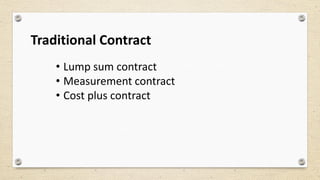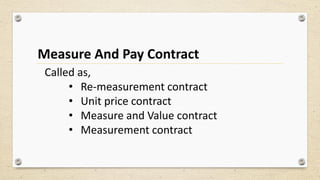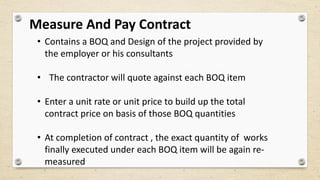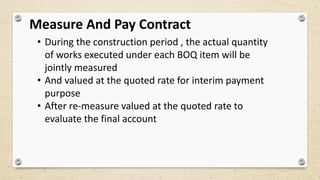Measure And Pay Contract
- 2. Procurement Strategies ï Traditional Contract ï Modern or Design & Build Contract ï Management Contract ï Collaborative Contract
- 3. Traditional Contract âĒ Lump sum contract âĒ Measurement contract âĒ Cost plus contract
- 4. Measure And Pay Contract Called as, âĒ Re-measurement contract âĒ Unit price contract âĒ Measure and Value contract âĒ Measurement contract
- 5. Measure And Pay Contract Re-measurement contracts are seldom used for an entire major construction project, but they are frequently used for agreements with sub-contractors
- 6. Measure And Pay Contract âĒ Contains a BOQ and Design of the project provided by the employer or his consultants âĒ The contractor will quote against each BOQ item âĒ Enter a unit rate or unit price to build up the total contract price on basis of those BOQ quantities âĒ At completion of contract , the exact quantity of works finally executed under each BOQ item will be again re- measured
- 7. Measure And Pay Contract âĒ During the construction period , the actual quantity of works executed under each BOQ item will be jointly measured âĒ And valued at the quoted rate for interim payment purpose âĒ After re-measure valued at the quoted rate to evaluate the final account
- 8. Measure And Pay Contract âĒ In variation or additional works that are without basis of BOQ rate(s) , the contractor can build up new rates or SRS for those works for valuation
- 9. Measure And Pay Contract This type of contract is fair with the employer ( Client ) at risk for total quantities
- 10. Requirements; âĒ Experience in developing bills of quantities âĒ Payment terms properly tied to measured work completion âĒ Quantity sensitive analysis of unit prices to evaluate total bid price for potential quantity variations
- 11. Requirements; âĒ Adequate breakdown and definition of work units âĒ Good quantity surveying and reporting system âĒ Sufficient design definition to estimate quantities of units âĒ Owner-furnished drawings and materials must arrive on time
- 12. Advantages âĒ Complete design definition not required at tender âĒ âTypicalâ drawings can be used for bidding âĒ Suitable for competitive bidding âĒ Easy for contractor selection âĒ Early project start possible âĒ Scope and quantities easily adjustable
- 13. Disadvantages âĒ The exact final price of the project is not known to the owner until the completion of the project âĒ More staff maybe needed to measure, control, and report on units completed âĒ Re-measurement contracts tend to draw unbalanced bidding
- 14. In comparing with lump-sum contract, - Changes in contract documents can be made easily by the owner - Lower risk for contractor.
- 16. Thank you















